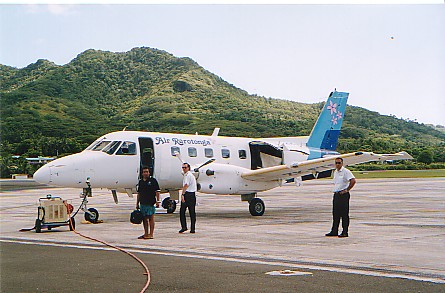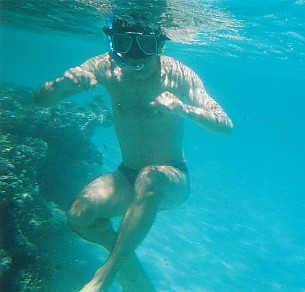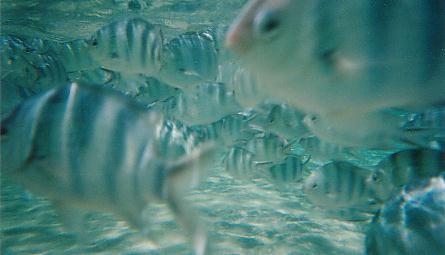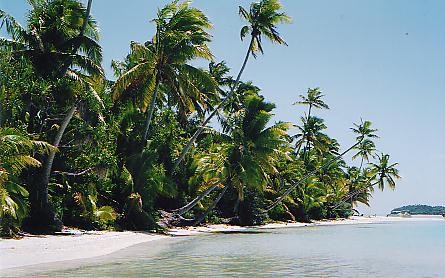22 February 2003: Avarua, Rarotonga, Cook Islands
This is my final afternoon on Rarotonga; this time tomorrow I'll be on a plane to Auckland, back in a temperate climate and arriving a day later than I started. Crossing the Date Line appeals to me somehow - like the equator it feels like one of the earth's seams, almost a weak point. In Computer Scientist speak, it is a Ghastly Hack to work around an inherent design flaw in this silly "round world" invention. And I constantly wonder if there are any other bugs in it: does it still work if I travel on a leap day, for example? When I was in La Paz investigating flights for this part of the journey one travel agent said that there were no direct flights from Tahiti to New Zealand, and that the quickest route would be to fly with Air France via Paris. I suppose that's another way to avoid the problem...
Rarotonga
The Cook Islands, named after Captain Cook, are spread out over a huge area of the pacific. Even getting to the other "Southern Group" islands from the capital means flying over hundreds of kilometers of empty ocean.
Rarotonga is the capital and largest of the Cook Islands. It has a population of about 8000, half of the total for the group (though there are more Cook Islanders living in New Zealand than there are here on the islands). All of the islands are the peaks of undersea volcanos, but in some cases the volcano itself has sunk below the ocean since decoming dormant and only a coral atoll remains. (The coral grows upwards as quickly as the volcano sinks.) Rarotonga, like Tahiti, has a central dormant volcanic peak and a fairly thin strip of flattish land around the outside, with one road going all round the island. In some places the reef is quite narrow and the ocean waves break near the coast, but elsewhere there is a kilometer or so of lagoon between the reef and the beach. There are even a few small islands on the reef in one corner.
The climate is hot and humid. When I arrived they had just been missed by a cyclone and it was quite wet and windy; since then it has not rained for more than a few minutes at a time, but it has been really humid. Much more so than in Costa Rica, for example. The economy is now based mainly on tourism; Air New Zealand flights between NZ and Los Angeles stop to refuel either here or nearby in Fiji or Tahiti, so it is not difficult to get here. They may once have exported tropical fruits (coconuts, bananas, pineapples, mangoes, avocados and papaya can all be seen growing wild) or fish but I don't see much evidence of that still going on. In fact it's extraordinary how dependent they are on imports from the outside world: bottled water from New Zealand, tinned tuna from Thailand, tinned pineapple from South Africa, and even imported tinned coconut milk! A small but flourising part of the economy is the postage stamp business. The Philatic Bureau also sells their own weird-and-wonderful coins - apparently they have a triangular one, but they are out of stock at the moment - and the famous Three Dollar Note.
So I spent about four days here, mostly on the beach. The best beach is at Muri, facing the islands where the lagoon is widest. It is quite a pleasant stretch of white coral sand, and it's possible to snorkel out on the reef. Unfortunately the snorkelling wasn't to great as the visibility was a bit poor, perhaps because of the recent bad weather. There is another beach at Black Rock which I discovered just before leaving; it also has nice sand and the snorkelling is closer to the shore.
For a bit of "culture" I went along to an Island Night at one of the restraunts here in Avarua. It's basically a show of traditional dancing, which involves lots of bottom-wiggling girls and jiggling men doing their stuff accompanied by a mainly percussion band. It was very impressive and entirely not like Morris Dancing.
Aitutaki
I decided that I had to see more of the Cook Islands than just Rarotonga so I flew to Aitutaki, the second largest island, in a 17-seater plane. (And I came back in a plane exactly the same size but with 24 seats jammed into it!)

Aitutaki has the dubious distinction of having been discovered by Captain Bligh just a couple of weeks before the famous mutiny. It is not much more than an atoll; there is a central lagoon with islands dotted around the periphery, though one of the islands is much bigger than all the others and reaches just over 100m at its highest point. This island has an ideal straight flat spot for an airstrip, and the Americans built not one but two here during WWII. (Previously, sea planes had called here to refuel on their way to Tahiti, landing in the lagoon.)

The highlight of the trip was a cruise out on the lagoon. I went out for a day trip and went snorkelling from the boat; this was exellent. Maybe there were more fish in Tahiti, but here there were incredible giant clams! They looked about three feet long but were probably less than that; they have extraordinary colour-schemes with bright blue lips and green and brown insides. I have never seen anything like them.

The boat captain had brought along some bread to feed to what he called "vegetarian piranhas", and dozens of these fish shot about looking for his offerings.

We also visited a few of the uninhabited islands which have really fabulous white beaches, and they treated us to an excellent lunch. This is "One Foot Island":

If the lagoon trip was the highlight, the lowlight was the Things That Went Bonk In The Night. Some of the noctural noises really were Bonks as coconuts fell from the trees, thudding into the sand. (I was staying in a rustic-style thatched beach hut.) Other noises were the huge cockroaches that seem to be everywhere in the pacific (did they arrive with the early explorers?). The ubiquitous ants do their stuff silently. Then my sleep was disturbed by a strange crunching noise. I reached out for my torch and shone it around to see the largest gecko ever... eating a cockroach! I thought that geckos only ate little things like mosquitos. Then a few hours later there was a louder weird noise. This time I scanned around with my torch and spotted - a crab climbing up into the roof!
So after all this back-to-nature stuff I'm quite looking forward to getting to Auckland. More news when I get there.